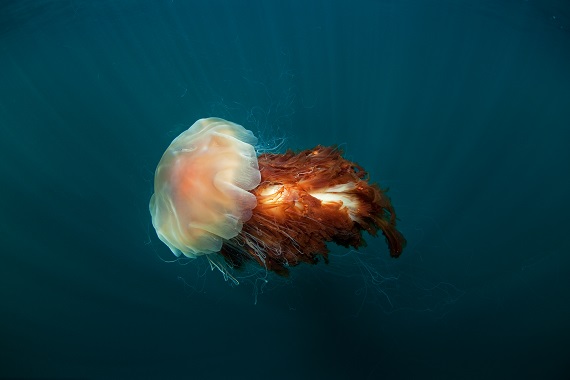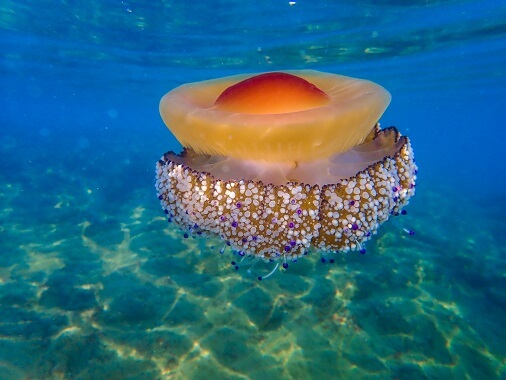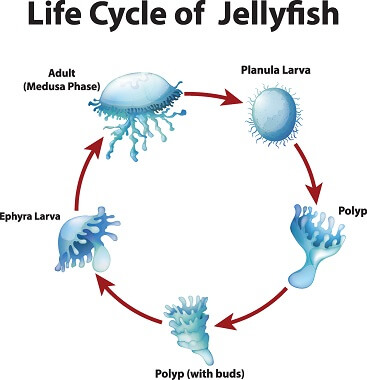
Jellyfish, also known as jellies, are fascinating animals that spend their lives floating in the oceans. Unlike their name suggest, jellyfish are not really fish as they lack a backbone. In fact, these animals are actually invertebrates and they are more closely related to corals, sea anemones, and sea whips than fish. These simple animals belong to the phylum Cnidaria and are composed of 95% water! While four of the classes that belong to the phylum Cnidaria are often considered as jellyfish, true jellyfish belong to the class Scyphozoa. Jellyfish are found in all oceans across the world, from tropical waters to the cold waters of the Arctic ocean, and have existed on Earth for billions of years – since before the time of the dinosaurs! Some inhabit deep ocean waters, but most live near the coast. Most species are dome-like in shape, with hanging tentacles that they use to sting and immobilize their prey. These animals have limited control over their movement but can move small distances by expanding and contracting a muscle in their body. Jellyfish are made up of three layers; epidermis, mesoglea, and the gastrodermis. The epidermis forms their outer layer which contains the nerve net. The middle layer is made up of the mesoglea which is a thick, elastic, jelly-like substance. The inner layer is the gastrodermis which contains the digestive cavity, a simple structure that acts as both a stomach and intestines and has only one opening which acts as both a mouth and an anus. Unlike a lot of other animals, jellyfish don’t have a brain. They also do not have blood or a heart. Their nervous system which is known as a nerve net is very simple and allows them to smell, detect light, and respond to other stimuli. All 200 species of jellyfish exhibit radial symmetry. This means that they have a distinct top and bottom, but do not have a left or right side as all of their appendages radiate outwards from a central point, rather like the spokes of a bicycle wheel. Not a lot is known about the ways that the various jellyfish species reproduce. The best-studied jellyfish belong to the genus Aurelia. These jellyfish have separate sexes and so the adults reproduce sexually. The males release their sperm through their mouths which then enter the surrounding water. These swim to the female and enter into her oral cavity where they are then able to reach the eggs. Once the eggs are fertilized, the fertilized eggs (zygotes) move into the oral arms where they spend some time developing and becoming larvae. The larvae settle on the seafloor and are now known as polyps. The polyps then begin to bud asexually and produce medusae which then develop into adults. Other true jellyfish species belonging to other genera may spend their lives solely as polyps or medusae and not alternate between the two different life stages in the same way. Jellyfish are one of the oldest animals on Earth and have changed very little from their prehistoric ancestors. These fascinating creatures have been studied by scientists for decades, increasing our understanding of the biological adaptations that have enabled them to persist in the world’s oceans for so long. Let’s take a closer look! Jellyfish are known for their sting! These animals have tentacles that have tiny sting cells on them called cnidocytes. These cells have tiny structures inside them that are full of venom, called nematocysts. When something touches a jellyfish these nematocysts shoot out and can penetrate the skin of the animal. The jellies use this mechanism to help capture prey or as a defense mechanism when they feel threatened. Like most venomous animals, the jellyfish inject their venom to cause pain and irritation. Jellyfish venom contains a type of protein called a porin which is responsible for the pain caused by their sting. This protein is not only found in the venom of all jellyfish but also in their relatives, including corals and anemones. Humans can also be stung by jellyfish which can result in mild symptoms such as pain and blistering, to more serious symptoms including whole-body illness. In some cases, stings can even be life-threatening. Many jellyfish species have the ability to produce their own light, in a process known as bioluminescence. This light is used primarily as a form of communication between animals and can be used for defense, offense, and intraspecific communication. The greatest diversity in jellyfish bioluminescence occurs in deeper water, where nearly every kind of jellyfish is luminescent and is mostly used in defense against predators. The light is produced by a chemical reaction between a chemical substance called luciferin and oxygen from the environment. This reaction releases energy and as a result, light is emitted. An enzyme called luciferase helps this reaction occur. For an animal to emit light regularly they must continually bring new luciferin into their system. Some animals acquire it through their diet while others can produce their own. Bioluminescence is found in many marine organisms including around 1500 species of fish! Some species of sea stars, crustaceans, worms, and sharks are also luminescent. Jellyfish are so cool they have even traveled into space! In 1991, some moon jellyfish were sent into outer space on board the Space Shuttle Columbia. This mission was a study conducted by scientists to understand how microgravity affected them. While in space, the number of jellyfish multiplied. On their return to Earth, the scientists examined these space-born animals and discovered that unlike Earth-born jellies, they couldn’t figure out how to deal with gravity. Scientists have sent a number of animals into space including monkeys, dogs, ants, cats, frogs, and fruit flies!
Kingdom
Animalia
Phylum
Cnidaria
Class
Scyphozoa
Order
3
Family
21
Genus
Multiple
Species
200
Niche
Carnivorous
Length
0.5 inches to 16 inches, though they can grow up to 7 feet
Weight
20-400g (0.7-14oz)
Lifespan
3 – 6 months
Social Structure
Live in groups
Status
The vast majority are not endangered
Natural Habitat
Ocean
Average Litter Size
100
Main food item
Small fish, fish eggs, larvae, plants, and other small marine creatures
Main threats
Sharks, birds, sea anemones, and tuna.
The Basics
Anatomy

Jellyfish Reproduction

Fun Facts about the Jellyfish!
Jellyfish Sting
Bioluminescence

Jellyfish in Space
